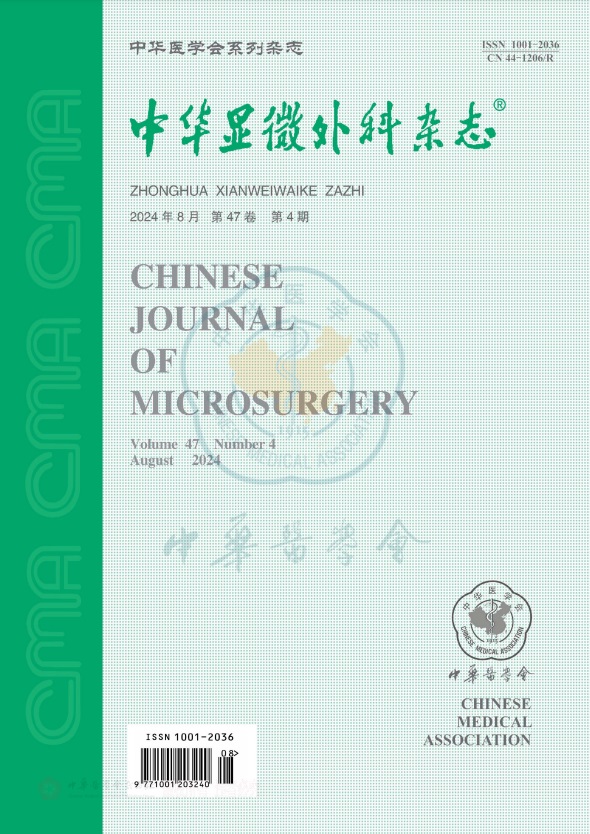Applied anatomy of the compression of the proper plantar digital nerves of the medial great toe
引用次数: 0
Abstract
Objective To identify the routes and branches of the proper plantar digital nerves(PPDN) in the medial of the great toe and its adjoining relationship among the surrounding fascia tissues and organs, which was expected to provide accurate localization of the nerve impingement and possible relevant of anatomical basis for the treatment of nerve entrapment in clinical utility. Methods From December, 2016 to January, 2019, a total of 54 formalin fixed feet were collected. Fifty of them were performed conventional anatomical procedure, the other 4 were prepared with sectional anatomical technique. The seats and branches of the PPDN in the medial of the great toe were observed; The width and thickness of the nerve were measured at the first metatarpophalangeal joint(FMPJ), along with its proximal and distal sides 0.5 cm. The origin and origin of fascia were observed by foot dissection. Masson staining was used to observe the tissue changes of the nerves in the FMPJ. Results The PPDN of the medial great toe run between the flexor pollicis longus tendon and the abductor pollicis tendon at the proximal, issued (4.21±0.12) final branches. And governed the sensation of the medial half of the great toe. The width of the nerve at the FMPJ was (3.50±0.09) mm, which was significantly increased compared with that of the near [(1.58±0.04) mm] and far [(1.56±0.03) mm] from the joint. The difference was statistically significant (P<0.05); The thickness of the nerve in the proximal segment was (0.83±0.04) mm, and that in the distal segment was (0.82±0.03) mm. Compared with that in the FMPJ [(0.67±0.02) mm], the difference was statistically significant (P<0.05). A deep fascia was observed on the superficial surface of the PPDN at medial great toe, which was stretched between the tendon sheath of the flexor pollicis longus tendon and the tendon of the abductor pollicis muscle. Masson staining showed obvious proliferation of nerve outer membrane fibers at the metatarpophalangeal joint, the number of nerve fiber bundles increased, and obvious thickening of nerve fiber bundles and nerve fascia. Conclusion Long-term compression can lead to thickening of the epineurium and perineurium, and the superficial fascia is an important factor of thumb pain and numbness caused by the compression of the PPDN at medial of the great toe. Key words: Proper plantar digital nerves; Great toe; Nerve conformity; Foot; Applied anatomy内侧大脚趾足底指神经压迫的应用解剖
目的明确大趾内侧足底指神经(PPDN)的路径和分支及其与周围筋膜组织和器官的毗邻关系,为神经撞击的准确定位提供依据,为临床治疗神经卡压提供可能的相关解剖学依据。方法2016年12月至2019年1月,收集福尔马林固定足54例。其中50例采用常规解剖方法,其余4例采用断层解剖方法制备。观察大趾内侧PPDN的位置和分支;测量第一跖指关节(FMPJ)及其近端和远端0.5 cm处神经的宽度和厚度。通过足部解剖观察筋膜的起源和起源。马松染色法观察FMPJ神经组织变化。结果大趾内侧部的PPDN在近端拇长屈肌腱和拇外展肌腱之间,有(4.21±0.12)个终支。控制着大脚趾内侧的感觉。FMPJ神经宽度为(3.50±0.09)mm,较近(1.58±0.04)mm和远(1.56±0.03)mm明显增加。差异有统计学意义(P<0.05);近段神经厚度为(0.83±0.04)mm,远段神经厚度为(0.82±0.03)mm,与FMPJ[(0.67±0.02)mm]比较,差异有统计学意义(P<0.05)。在大趾内侧PPDN浅表面可见深筋膜,该筋膜位于拇长屈肌腱肌腱鞘和拇外展肌肌腱之间。马松染色显示跖指关节神经外膜纤维明显增生,神经纤维束数量增加,神经纤维束和神经筋膜明显增厚。结论长期压迫可导致神经外膜和神经会膜增厚,浅筋膜是拇趾内侧PPDN压迫引起拇指疼痛和麻木的重要因素。关键词:足底固有指神经;大脚趾;神经整合;脚;应用解剖学
本文章由计算机程序翻译,如有差异,请以英文原文为准。
求助全文
约1分钟内获得全文
求助全文
来源期刊
CiteScore
0.50
自引率
0.00%
发文量
6448
期刊介绍:
Chinese Journal of Microsurgery was established in 1978, the predecessor of which is Microsurgery. Chinese Journal of Microsurgery is now indexed by WPRIM, CNKI, Wanfang Data, CSCD, etc. The impact factor of the journal is 1.731 in 2017, ranking the third among all journal of comprehensive surgery.
The journal covers clinical and basic studies in field of microsurgery. Articles with clinical interest and implications will be given preference.

 求助内容:
求助内容: 应助结果提醒方式:
应助结果提醒方式:


